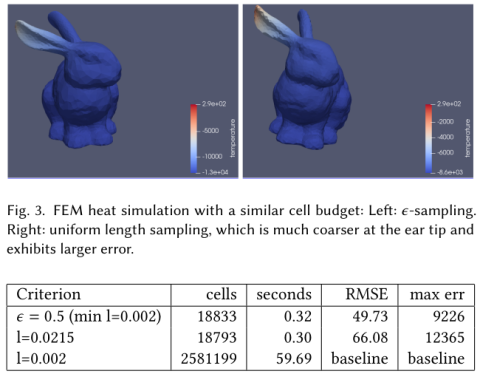Motivation
Based on existing meshes, or other surface representations, volumetric meshing creates a partitioning of the interior of the surface, e.g., by tetrahedralizing it. Finite Element Method (FEM) rely on volumetric meshing to run simulations, such as to simulate heat distribution over time (as seen in the example image). The computational runtime and resolution depends directly on the number and size of elements. We are developing an algorithm that creates surface meshes with triangle sizes based on the local feature size. A volumetric meshing based on these sizes could enable both more fine-grained simulation at small features while accelerating the total simulation at no loss of precision by placing large tetrahedra in the interior or at larger features.
Description
This requires parametrizing and evaluating a few existing meshing algorithms to determine which one is most applicable to reach the goal of more precise/faster (or both!) simulation. Also, to evaluate and show the applications, a few types of simulation have to be added. Sharp features have to be handled as well, these are typically contained in human-made objects, e.g., from CAD.
Some meshing algorithms:
Tetgen: https://wias-berlin.de/software/tetgen/
Fast TetWild: https://github.com/wildmeshing/fTetWild (it also has a subset of the thingi10k dataset in the repo)
CGAL: https://doc.cgal.org/latest/Mesh_3/
Potential simulation software:
ElmerFEM for the simulation (currently a heat simulation because it can also produce nice pictures): https://www.elmerfem.org/
VertexBlockDescent to demonstrate the runtime/quality tradeoff: https://ankachan.github.io/Projects/VertexBlockDescent/index.html
Tasks (depending on PR/BA/DA and number of students)
- Parametrize the above meshing algorithms such that they can produce the desired size variations, e.g., in function of local feature size (LFS) and signed distance function (SDF) from the surface
- Choose several simulation types as a variety of applications and install them to run on the generated volumetric meshes
- Evaluate the quality of the generated interior elements, the results of the simulations, and document the best algorithm/parameters
- Show the applicability of the algorithms to meshing and processing sharp features correctly
Requirements
- Knowledge of English (source code comments and final report have to be in English)
- Experience in geometry processing is a plus
Environment
A bonus of €500/€1000 if completed to satisfaction within an agreed time-frame of 6/12 months (PR/BA or DA)can also
